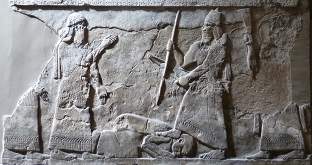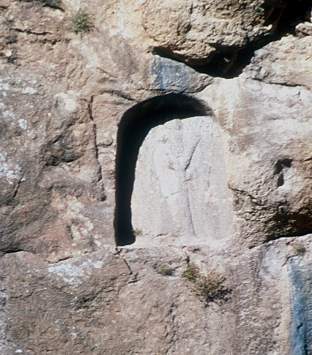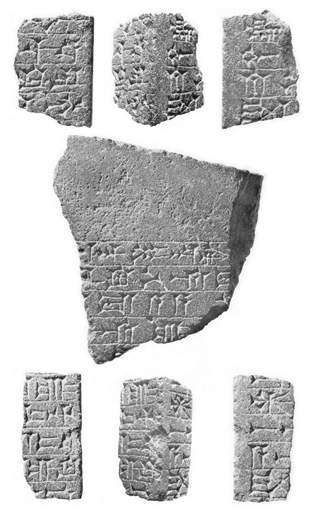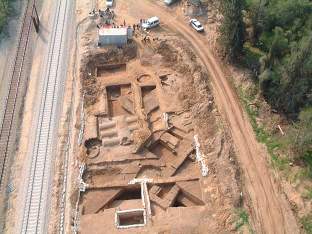Gaza, Ashdod and the other Philistine kingdoms
Philistia comprised the southern coast of modern Israel. In the 8th century BC it was organised in several independent kingdoms, centred around four cities: Gaza, Ashkelon, Ashdod and Ekron. The region acted as a buffer zone between the expanding might of the empires of Assyria and Kush and frequently provided a stage for their relationship to play out, in hostile and peaceful ways.
Gaza, a city of trade at the convergence of the via maris and the Incense Route
Gaza is the southernmost of the Philistine cities. It is the terminus of the important trade route running along the Mediterranean coast to the Nile Delta, the via maris. The city also served as the end destination of the Incense Route across the Arabian Peninsula. This unique position made Gaza one of the most important trade centres in the eastern Mediterranean.

Hanunu of Gaza, shown on his knees in front of Tiglatpileser III, formally submits to the king of Assyria. Stone relief from the wall decoration of Tiglatpileser's palace at Kalhu. British Museum, WA 118933; photo by Karen Radner. View large image.
During the reign of Tiglatpileser III (744-727 BC) the city of Gaza was ruled by Hanunu. In 734 BC, faced with the advancing Assyrian army, Hanunu fled to neighbouring Egypt, control over which was then split between a number of dynasts in the Delta and the kingdom of Kush in the south. Historically and economically, Gaza and the Nile Delta enjoyed a close relationship and we can safely assume that Hanunu was seeking protection against Tiglatpileser. However, no help was forthcoming and Hanunu eventually returned to his city.
The Assyrian king reinstated Hanunu on the throne of Gaza. However, the city was turned into an Assyrian dependency, more specifically a trading station (bīt kāri), no doubt set up to take advantage of its ideal location at the nexus of the converging trade routes from Egypt and Arabia. Tiglatpileser commemorated this event, which cemented the Assyrian presence on Egypt's border, by setting up a stele at the Brook of Egypt (Nahal Muṣur, modern Nahal Besor), a wadi south of Gaza. The stele has not been found but we know of it from Tiglatpileser's inscriptions at his royal palace at Kalhu which relate the Gaza episode in some detail.
Hanunu of Gaza falls foul of Sargon II
Hanunu's rule outlasted that of Tiglatpileser and Shalmaneser V (726-722 BC), but events early in the reign of Sargon II (721-705 BC) led to his downfall. In 721 BC, perhaps still smarting from Tiglatpileser's humiliation of Gaza, Hanunu took advantage of the political instability which accompanied Sargon's accession and joined the anti-Assyrian coalition led by Yau-bi'di of Hamat (modern Hama) in central Syria. The coalition had no success in breaking free from Assyria's control: after smashing the Hamat-led forces at the city of Qarqar, Sargon marched south against Hanunu of Gaza and his allies, among them troops dispatched by an Egyptian ruler. His name is lost in the Assyrian accounts of these events but he is thought to have been Tefnakhte, king of Saïs in the western Delta. The Assyrian army met the allied forces at Rapihu (modern Raphia), just south of Gaza, and defeated them.

View of the relief of Sargon II of Assyria at the rock cliff of Tang-i Var as seen from below. The inscription covering the depiction of king Sargon mentions his interaction with Shebitku, king of Kush, and the extradition of Yamani, rebel king of Ashdod (see "Ashdod between Assyria and Kush" below). Photo by Michael Roaf. View large image.
Sargon's treatment of Hanunu was far less lenient than Tiglatpileser's had been, no doubt because this time the king of Gaza had not just avoided an encounter by taking flight but had engaged in open rebellion. Nevertheless, Gaza and Hanunu appear to have got off relatively lightly. While Sargon boasts of his punitive measures against Qarqar, the flaying of Yau-bi'di and the killing of co-conspirators, Hanunu is said to have been deported to Assyria and no more is mentioned about his fate. It is possible that he was brought to the Assyrian heartland in order to take part in a ritual victory celebration or in order to publicly swear loyalty to Sargon, an elaborate affair whose theatrical elements are particularly well illustrated in surviving loyalty treaties from the 7th century BC (see e.g. SAA 2 6).
Gaza itself was not annexed as an Assyrian province but maintained its nominal independence as a vassal state of the Empire. On the one hand, this reflects the region's strategic importance for trade with Egypt and Arabia, and Sargon's reluctance to antagonise the city and especially its trade partners. On the other hand, Gaza had an important role to play as a buffer state against the powers in Egypt and the Arab tribes. In 716 BC, Sargon reinforced Assyria's presence in the sensitive border region by settling deportees "on the border of the City of the Brook of Egypt" and appointing the sheikh of the Laban tribe to rule over them, establishing what amounted de facto to an Assyrian military outpost in the area.
Ashdod between Assyria and Kush

The three surviving fragments of the basalt stele of Sargon II from Ashdod, excavated in 1963 in two separate locations and in secondary contexts on the acropolis. The stele was erected in 711 BC (or shortly after) when Ashdod was made the centre of an Assyrian province and smashed in 705 BC (or shortly after) when Ashdod broke free of Assyrian rule after Sargon's death. From M. Dothan (ed.), Ashdod II-III: the second and third seasons of excavations, 1963, 1965, soundings in 1967 (Atiqot, English Series 9-10), Jerusalem: Department of Antiquities and Museums, 1971, pl. XCVI and XCVII. View large image.
Almost a decade after Sargon's defeat of Hanunu, events in another Philistine city, Ashdod, acted as a catalyst in international politics and led to an unprecedented interaction between Assyria and Kush, now in control of a largely united Egypt (see Kush). The episode probably dates to 711 BC and is described in detail in Sargon's so-called Great Summary Inscription, found in his capital city of Dur-Šarruken. The inscription records that Azuri, king of Ashdod, refused to pay tribute to Assyria, in direct contravention of his duty as a vassal king, and moreover plotted against Assyria with neighbouring rulers. As a result, the Assyrian king had the insubordinate Azuri replaced with his more compliant brother Ahi-miti. In this, Sargon followed Assyria's usual practice of supporting a sympathetic but legitimate claimant to the throne of a vassal kingdom. But this interference in their affairs was not well received by the inhabitants of Ashdod who overthrew Ahi-miti almost immediately after his appointment in favour of one Yamani, a man with no claim to the throne but certainly a leading role among the insurgents.
Yamani attempted to form an anti-Assyrian coalition, approaching other Philistine cities as well as the rulers of Judah, Moab and Edom. He also repeatedly contacted the Delta ruler Bakenranef of Saïs, Tefnakhte's successor, but his appeals went unanswered. When Sargon marched on Ashdod in retaliation, Yamani wasted no time and, in a scene reminiscent of Hanunu's flight from Gaza before the advancing Tiglatpileser III, he too fled to territory outside Assyria's reach, into the Kushite sphere of influence. Sargon invaded Ashdod and ended its independence, turning it into an Assyrian province and the new southwestern boundary of the Empire. Excavations in Ashdod, under Moshe Dothan, have brought to light evidence of these events: 3,000 skeletons, buried in a mass grave, are thought to be victims of the Assyrian conquests while three fragments of the basalt stele which Sargon had erected at Ashdod in celebration of his victory were recovered in the acropolis of the city.
Yamani's exact destination is unclear, but he probably reached a point somewhere in Upper Egypt which was then under the control of Shabako, king of Kush. According to the inscription of Sargon II at Tang-i Var in western Iran, Yamani remained there – presumably with official approval – until Shabako's death in 707 or 706 BC. His successor, Shebitku, then chose to reverse the existing policy. He opened a diplomatic charm offensive to Sargon and extradited Yamani to Assyria "in manacles and handcuffs" as an accompanying gesture of goodwill.

The remains of an Assyrian palatial building at Ashdod, dating to the late 8th century BC, during excavations in 2003. Photo from the Biblical Archaeology Review website (BAR 33:1, Jan/Feb 2007). View large image.
The friendly relations between Assyria and Kush were not to last, however. Ashdod broke free of Assyrian supremacy as soon as Sargon died in 705 BC and it is thought that this is when Sargon's stele at Ashdod was smashed. Its new ruler Mitinti formed another coalition against Assyria, now under the rule of Sargon's successor Sennacherib (704-681 BC). Together with two other Philistine kings, Ṣidqa of Ashkelon and Padi of Ekron, he entered into an alliance with the neighbouring rulers of the Phoenician city-states, of Judah, Ammon, Moab and Edom, and this time they received ample military support from Shebitku's Kushite and Egyptian troops. What prompted the drastic change in Kushite foreign policy towards Assyria is unclear in detail, but the relations between the two empires never recovered after Kush's involvement in the resulting battle of Eltekeh in 701 BC.
While Ashkelon, Ekron and Ashdod fought openly and prominently against Assyria, Gaza, under its ruler Ṣil-Bel, remained neutral: this would seem to indicate the effectiveness of the military control of the Laban tribe as established under Sargon II. After the confrontation at Eltekeh, the conflict continued in Judah and when the Assyrian troops left the region, Sennacherib adjusted the borders at Judah's expense, rewarding the neighbouring rulers with regions formerly under Judean control. That Gaza, which had remained off the battlefield, was thus remunerated is easy to understand but Ekron and Ashdod also profited from the new arrangement - testament that despite their insurrection, these Philistine cities were too important in the international politics of the ancient Near East for Assyria to ignore or alienate.
Further reading:
Kapera, 'The Ashdod stele of Sargon II', 1976.
Kitchen, 'The Third Intermediate Period in Egypt', 1986.
Tadmor, 'Philistia Under Assyrian Rule', 1966.
Uehlinger, 'Hanun von Gaza und seine Gottheiten', 2002.
Content last modified: 20 Jul 2021.
Karen Radner & Silvie Zamazalová
Karen Radner & Silvie Zamazalová, 'Gaza, Ashdod and the other Philistine kingdoms', Assyrian Empire Builders, University College London, 2021 [http://oracc.museum.upenn.edu/saao/aebp/essentials/countries/philistia/]